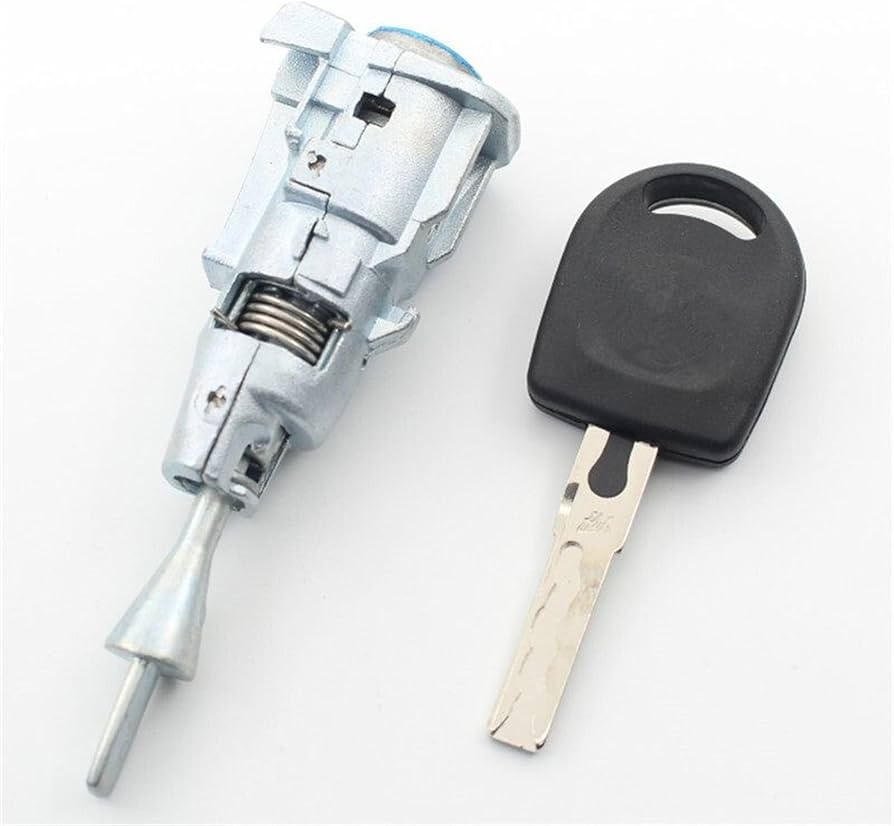Ever wondered about the unsung heroes that keep your car secure? We’re talking about car door locks! These essential mechanisms are more complex than they appear, comprised of various parts working in harmony. Understanding the names of these Car Door Lock Parts Names not only satisfies curiosity but also empowers you with knowledge for maintenance or troubleshooting. Let’s embark on a journey to dissect the anatomy of your car door lock and learn the names of each component.
Alt text: Detailed diagram showcasing various car door lock parts names, including exterior handle, key cylinder, door lock tumbler, latch, linkage rods, actuator, solenoid, and locking module.
Exploring the Exterior Car Door Lock Components
Let’s begin our exploration with the parts you interact with directly on the outside of your car door.
Exterior Door Handle: Your Entry Point
The exterior door handle is your primary interface with the car door lock. It’s the lever or grab you use to initiate the door opening process. Designs vary across car models, but their function remains the same: to engage the internal mechanisms when pulled or activated.
Key Cylinder: The Traditional Access Point
The key cylinder is where you insert your physical car key. This component houses intricate mechanisms that, when matched with the correct key, allow the lock to be manually overridden. It’s a vital part of the car door lock system, serving as a traditional security measure and often as a backup in modern vehicles.
Door Lock Tumbler: The Security Core
Nestled within the key cylinder is the door lock tumbler. This is the heart of the mechanical locking system. It contains a set of pins or wafers that must be arranged in a specific order by your key for the cylinder to turn. The tumbler is crucial for preventing unauthorized access, ensuring only the correct key can unlock your car.
Latch: Securing the Door
The latch is the robust mechanism that physically holds your car door closed. When you shut your door, the latch engages with the door frame, preventing the door from swinging open while driving. It’s a critical safety component, ensuring the door remains securely fastened.
Delving into the Interior Car Door Lock System
Moving inside the door panel, we encounter the components that work behind the scenes.
Linkage Rods: Connecting the Actions
Linkage rods are metal bars that act as connectors within the door. They transmit motion from the exterior handle and key cylinder to the internal locking mechanisms, such as the latch and actuator. These rods ensure that when you operate the handle or key, the desired action – locking or unlocking – is effectively carried out.
Actuator: Powering Automatic Locks
The actuator is an electromechanical device responsible for power door locking and unlocking. In modern vehicles with central locking systems, the actuator receives signals from the car’s computer or remote key fob. It then moves the locking mechanisms, providing the convenience of automatic door locks.
Door Lock Solenoid: The Electrical Switch
Often working in conjunction with the actuator, the door lock solenoid is an electromagnetic switch. When energized, it facilitates the movement of the locking mechanism. In essence, it’s the electrical component that translates electronic commands into physical locking or unlocking actions within the car door lock assembly.
Locking Module: The Control Center
The locking module, or door lock control module, acts as the brain of the power door lock system. It receives inputs from various sources – such as the remote key fob, door switches, and vehicle security system – and controls the actuators and solenoids accordingly. This module ensures all door lock components work in a coordinated and secure manner.
Troubleshooting Common Car Door Lock Issues
Understanding these parts can be helpful when facing common car door lock problems.
Frozen Door Locks: Winter Woes
Frozen door locks are a frequent issue in colder climates. Moisture can enter the lock cylinder and freeze, preventing the key from turning. Solutions include using de-icer sprays specifically designed for locks or gently warming the key.
Key Stuck in Ignition: A Frustrating Problem
A key stuck in the ignition can sometimes be related to door lock issues. If the car doesn’t recognize that the driver’s door is open (due to a faulty door lock sensor), it might not release the ignition key. Addressing door lock sensor problems can resolve this issue.
Frequently Asked Questions about Car Door Locks
How to Maintain Your Car Door Locks?
Regular maintenance is key to prolonging the life of your car door lock mechanism. Lubricating the key cylinder and latches with graphite lubricant periodically can prevent sticking and ensure smooth operation.
Can I Replace Car Door Lock Parts Myself?
Some simpler components, like the exterior handle, might be replaceable by a DIY enthusiast. However, more complex parts like the tumbler, actuator, or locking module often require specialized tools and expertise. It’s advisable to consult a professional mechanic for intricate repairs.
What to Do If My Key Won’t Turn in the Lock?
If your key refuses to turn, first try lubricant spray. If the problem persists, avoid forcing it, as this could damage the key or lock. Seek assistance from a locksmith or mechanic to diagnose and resolve the issue.
Are Modern Car Door Locks More Secure?
Yes, modern car door locking systems are generally more sophisticated and secure. They often incorporate electronic components, remote locking, and enhanced mechanical designs, offering improved protection against theft.
Can I Upgrade My Car Door Locks for Better Security?
Upgrading your car locks is possible. Options include installing higher-security aftermarket locks or adding features like alarm system integration. Consult with a car security specialist to explore available upgrades for your vehicle.
Are Car Door Lock Parts Universal Across All Models?
While the fundamental car door lock parts are similar across most vehicles, specific designs and compatibility vary significantly between makes and models. Always ensure replacement parts are specifically designed for your car’s year, make, and model.
 Car door lock mechanism detail
Car door lock mechanism detail
Alt text: Close-up image detailing the intricate mechanism of a car door lock, highlighting the complexity and precision engineering of these security systems.
Choosing the Right Car Door Locks
When selecting replacement car door locks or components, consider factors like quality, security rating, and compatibility with your vehicle. Opting for reputable brands and ensuring correct fitment are crucial for reliable performance and security. Explore online and offline retailers to find the appropriate parts for your needs. Websites specializing in car parts, like JUNYING (lockcomponent.com), offer a range of options and expertise in automotive locking systems.
Conclusion: Mastering Car Door Lock Parts Names
Understanding the car door lock parts names and their functions demystifies a critical aspect of your vehicle’s security. This knowledge empowers you to better maintain your car, troubleshoot minor issues, and communicate effectively with mechanics when repairs are needed. By familiarizing yourself with these components, you gain a deeper appreciation for the engineering that keeps your vehicle safe and secure.
